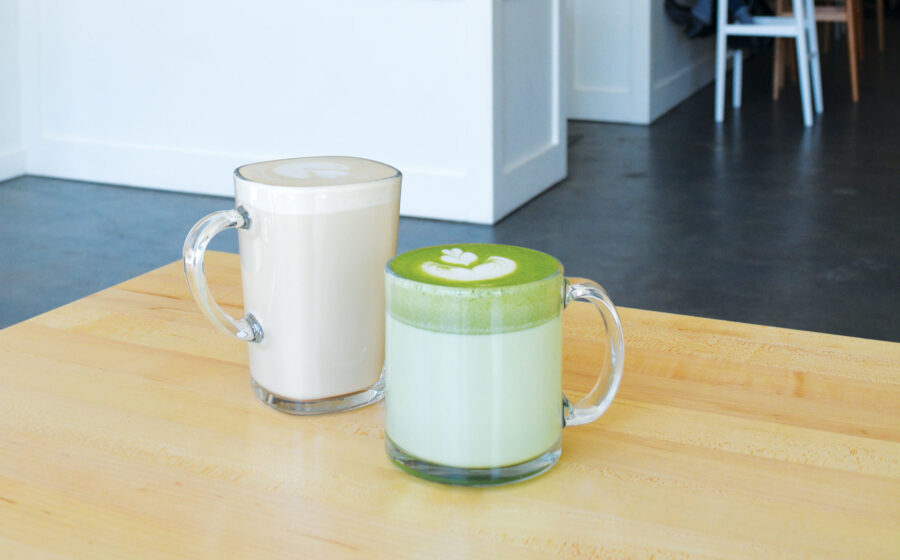Tea lattes exist in an uncomfortable place in the specialty coffee and tea worlds, a somewhat misunderstood coupling of both beverages hampered by their popularization in big chains.
The London fog, the chai latte—these are common manifestations. But can the tea latte go beyond those standbys, simultaneously honoring the complexity of tea and barista craft?
An Affirmative Collaboration
“Absolutely,” says Lucky Rodrigues, founder of Insight Coffee in Sacramento, who created the recipe for his matcha latte in 2007. “The reality is that coffeehouses tend to attract people who appreciate coffee, but what comes with that culture, and what some operators forget, is that those people bring along others who aren’t really into coffee but appreciate the craft.”
From a café’s perspective, tea lattes aren’t only comforting drinks: they can act as the bridge between sugary, accessible drinks and traditional tea preparations of, say, a pu-erh or classic yerba mate. They also round out menu offerings and give cafés an expansive canvas for creativity.

Tea lattes are simple: steeped tea with milk, either steamed or cold, and sometimes a sweetener. The strength of the infusion depends on the tea style. Standard tea lattes include the London fog (Earl Grey tea and sweetened milk, sometimes with lavender or vanilla) and the chai latte (about which an entire volume could be written). But increasingly, bright green matcha lattes, smoky lapsang souchong lattes, and cooling mint lattes are also making their way onto tea and coffee bar menus across the country.
“From the business side of things, tea lattes really aren’t much more complicated to make than simple tea infusions,” says Kate Blackman, barista trainer, menu developer, and former quality control supervisor at Parisi Artisan Coffee in Kansas City. “And the market allows you to price it much higher. So it can be a great profit item for cafés.”
Details Matter
Tea Chai Té, a two-location company in tea-loving Portland, boasts a massive tea menu divided into categories ranging from black to pu-erhs to green to rooibos, and every tea can be made latte-style. The resulting drinks aren’t just staggering in their variety, but they draw the tentative palate from the familiarity of more commonly known sweet and spicy masala chai to unconventional tea lattes like coconut chai and ginger green chai and more delicate offerings like silver needles white tea latte. The teas are complemented, not overshadowed, by various kinds of milk and sweeteners.
Each ingredient influences the end product, but Brandon Langlois of Tea Chai Té says, “The milk is the biggest part of the drink, so how you treat it is hugely important.” At Tea Chai Té, tea lattes are made by steeping the tea with hot water and milk. The length of steeping time and the order in which water and milk are added change depending on the tea. A delicate white tea will be steeped in the milk alone, while a hearty Assam will be started with 190-degree water and the milk added a minute after.
Far more than simply a sweet, milky drink, the tea latte can fulfill its promise by beckoning customers into a deeper world of tea culture.
Erica Indira Swanson, the owner of Portland’s recently opened Tea Bar, has many plans ahead for signature tea lattes, but finding the best brewing recipe for each tea is her top priority.
“First, I get to know the tea well; then I figure out the tea and water ratio,” she says. “Next is the brewing time and water temperature. For example, yerba mate brewed at 212 will often come out bitter. But if we flush the leaves at 175 and then brew at 212, it’s brilliant.”
Whether tea lattes are infused to order or made with tea concentrates batched ahead of time, standardized preparation is essential for quality. Blackman advises using a scale for all proportions. “One person’s teaspoon is not the next person’s teaspoon,” she says. A timer and a pre-programmed water tower also make it possible to ensure consistent steeping. Whether you aim for the drink to be balanced or startling, experiment with the teas, the sweeteners—from simple syrups to local raw honey—and your milks (or alternative milks).
Far more than simply a sweet, milky drink, the tea latte can fulfill its promise by beckoning customers into a deeper world of tea culture. Emerging from a fog of bergamot, it may be the next great drink for the specialty industry.
Emily McIntyre is a regular contributor to Fresh Cup. She is the co-owner of Catalyst Coffee Consulting in Portland. Photos by Cynthia Meadors.
This story was originally published on May 12, 2015 and has been updated to meet Fresh Cup’s current editorial standards.
















